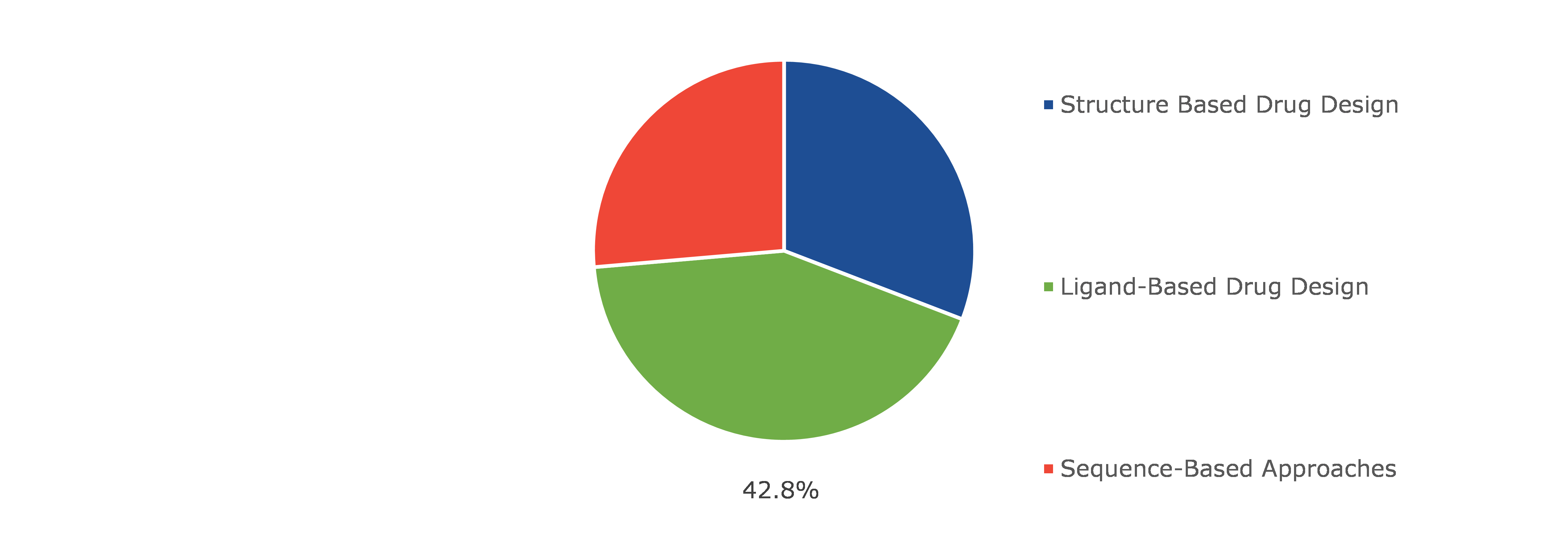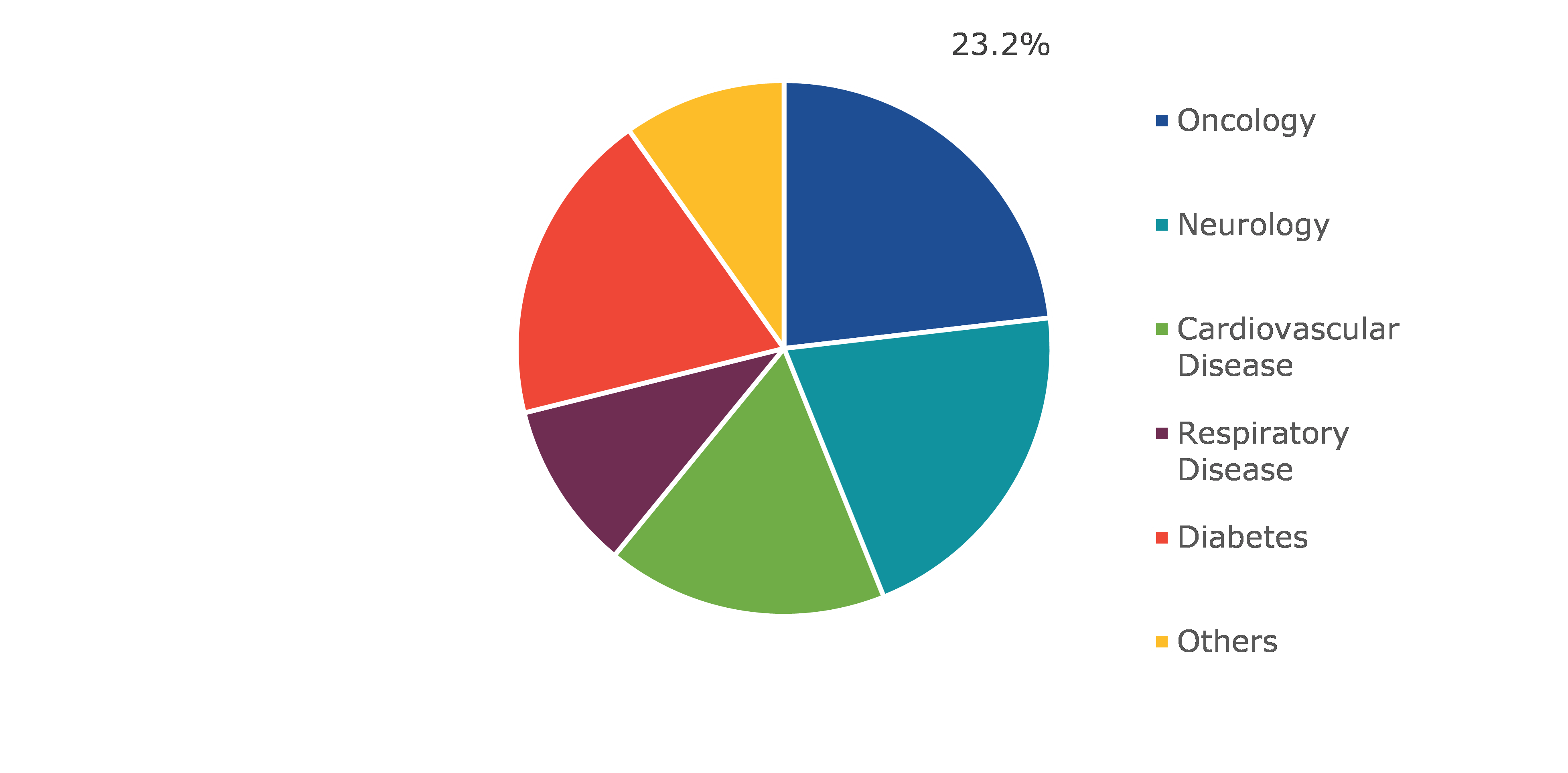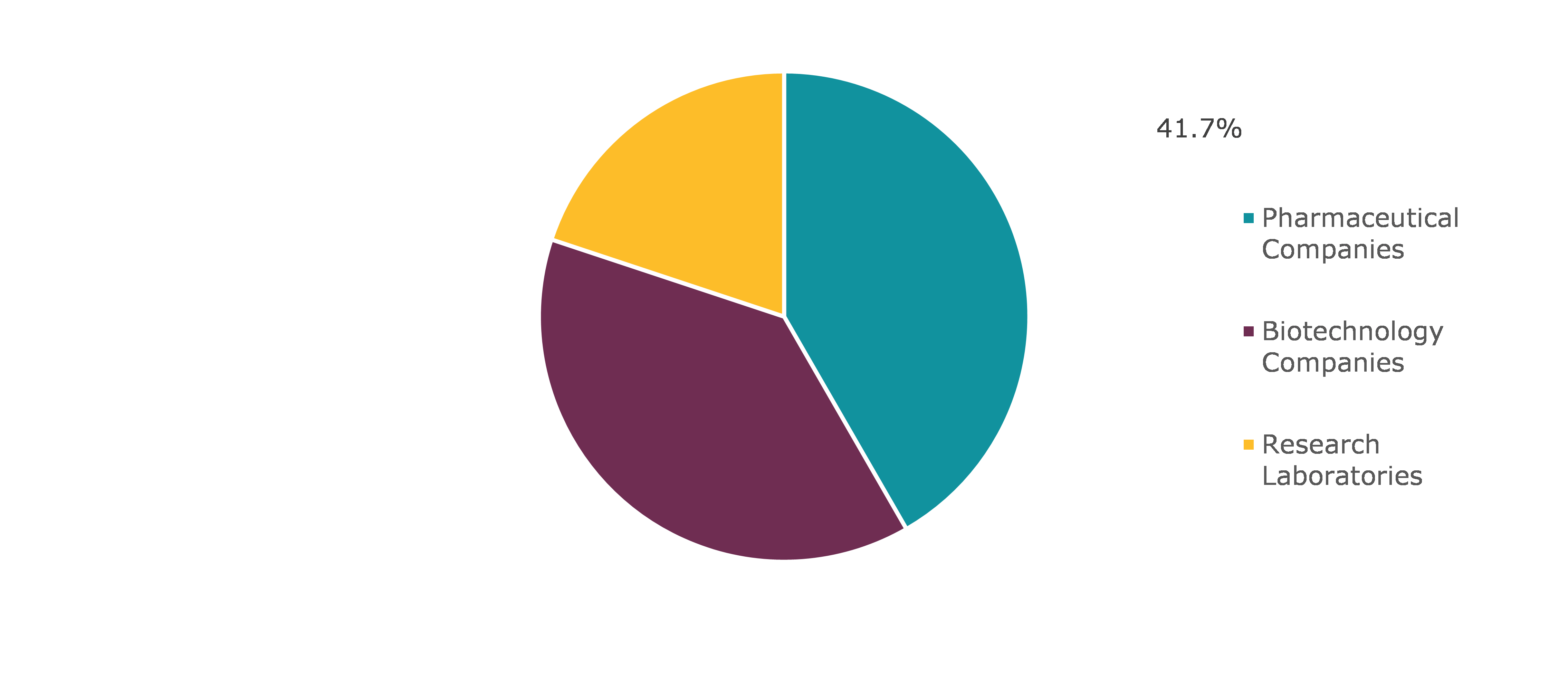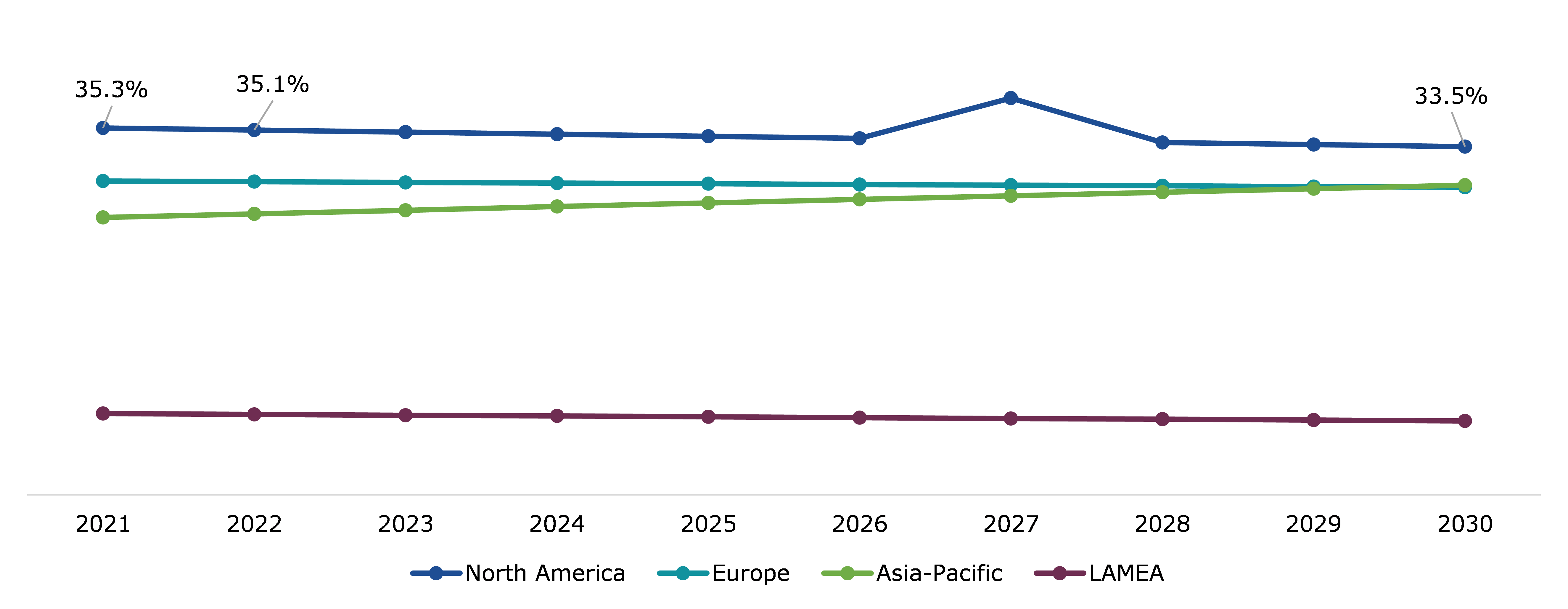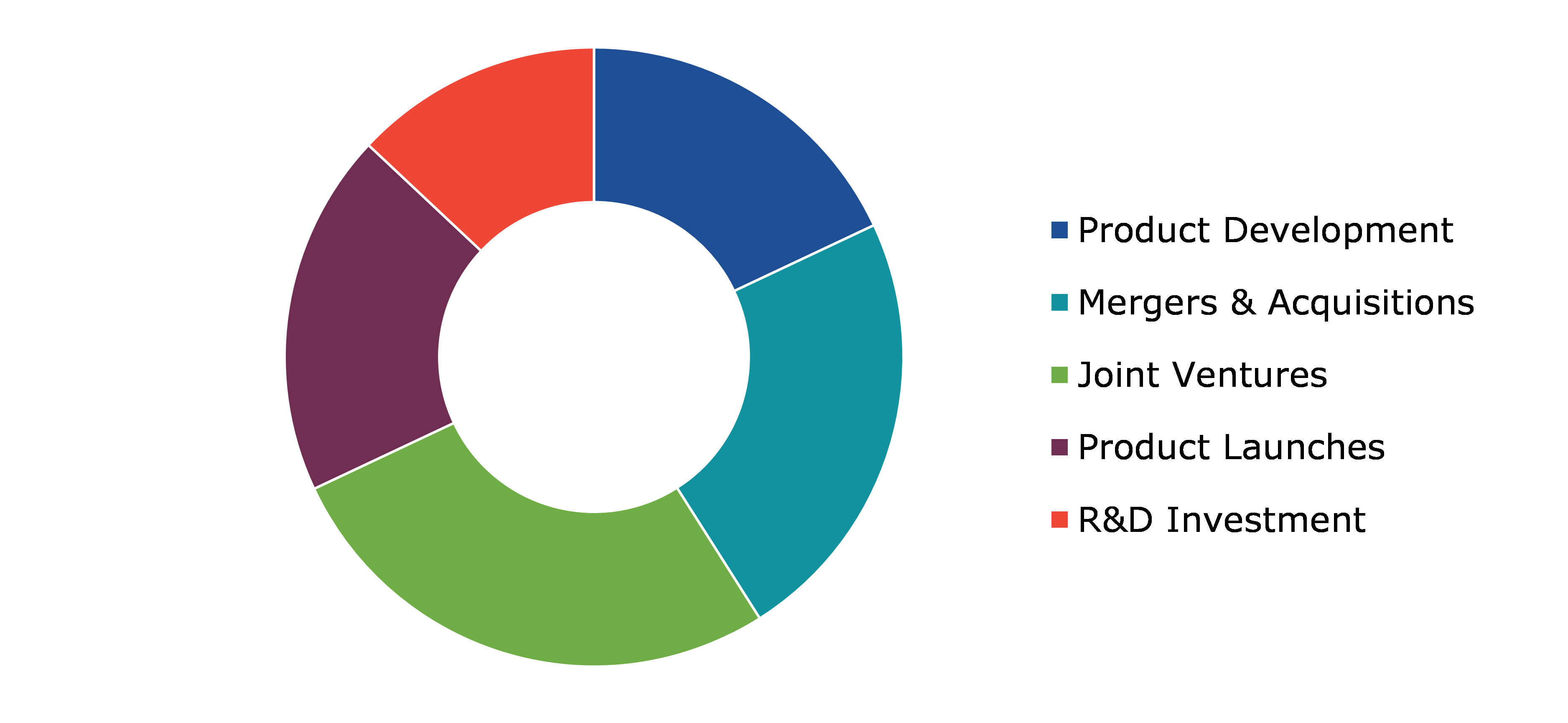Computer-aided Drug Discovery Market Report
RA00159
Computer-aided Drug Discovery Market by Type (Structure-based Drug Design (SBDD), Ligand-based Drug Design (LBDD), and Sequence-based Approaches), Therapeutic Area (Oncology, Neurology, Cardiovascular Disease, Respiratory Disease, Diabetes, and Others), End-user (Pharmaceutical Companies, Biotechnology Companies, and Research Laboratories), and Regional Analysis (North America, Europe, Asia-Pacific, and LAMEA): Global Opportunity Analysis and Industry Forecast, 2022–2030
Global Computer-aided Drug Discovery Market Analysis
The global computer-aided drug discovery market size is predicted to garner a revenue of $7,504.7 million in the 2022–2030 timeframe, growing from $2,940.9 million in 2021, at a healthy CAGR of 11.48%.
Market Synopsis
Increasing cases of chronic and unknown diseases worldwide are expected to accelerate the need for rapid drug development, driving the computer-aided drug discovery market in the forecast timeframe. Computer-aided drug discovery (CADD) is a modern technique in which researchers and analysts use a combination of software to analyze, design, develop, monitor, and study a three-dimensional structure of the target disease molecule and its complement biomolecule ligand. Researchers widely use this method because it expedites research and drug discovery. Strategic alliances among market players, along with growing demand for drugs, are expected to accelerate the growth of the computer-aided drug discovery market.
Moreover, chronic diseases, such as cardiovascular disease have become increasingly common in recent years. According to the World Health Organization (WHO), the United Nations (UN) specialized agency responsible for international public health, the number of CVD patients could reach 23 million by the end of 2030. Furthermore, according to Premier, Inc., a well-known healthcare improvement company, the demand for novel drugs for the treatment of CVD conditions has skyrocketed as a result of the COVID-19 crisis. The facts and figures presented above show that the need for the development of new drug molecules is expected to increase, which may have a positive impact on the global computer-aided drug discovery market during the analysis period.
However, a shortage of skilled labor to operate computer-aided drug discovery solutions may stymie global market growth. Also restraining the global computer-aided drug discovery market is lower product penetration in emerging economies.
According to the regional outlook, the Asia-Pacific computer-aided drug discovery market is expected to create massive growth opportunities for market investors by growing at a CAGR of 12.84% during the review period.
Computer-aided Drug Discovery Overview
Computer-aided drug discovery (CADD) is a cutting-edge computational method used in drug discovery to identify and implement potential leads. Computational chemistry, molecular modelling, molecular design, and rational drug design are all aspects of computer-aided drug design. CADD is being used to improve the quality of identified leads. CADD methods are garnering popularity and acceptance in both academic and pharmaceutical circles. CADD saves time; it is quick and inexpensive.
CADD is an effective tool in the world drug development for identifying potential therapeutic compounds. It is now the best choice for elevated screening, which is commonly used in drug design. CADD techniques/tools have been used in almost every stage of the drug development pipeline as they have the capacity to accelerate the process of hit identification, strike to lead, as well as result enhancement. Over last two decades, advances in the computer-aided drug designing procedure at the technique/tool level, combined with development of computational power, have enabled the science world to start generating disease-oriented fast and reliable remedies at low cost and in a manageable time space.
COVID-19 Impact on Computer-aided Drug Discovery Market
Though the novel coronavirus pandemic had a devastating effect on several industries, the computer-aided drug discovery market experienced a significant growth during this period. The market for computer-aided drug discovery has seen high rate of growth owing to increased R&D activities among the scientists, researchers, and biotechnological & biopharmaceutical companies to restrict the spread of the coronavirus disease. Increasing transmutation rate of coronavirus has motivated the scientists across the world to discover an effective treatment or a drug against this deadly virus. Therefore, the importance of research and drug discovery has skyrocketed, thus driving the growth of the market.
Due to the coronavirus pandemic in 2020, many companies have improved their technology sector by investing a huge amount of their revenue in their research & development activities. Some companies have adopted partnership & collaboration as their tool to expand their business in the market. For instance, according to a news published on Cision PR Newswire, on March 23, 2021, Model Medicines, an artificial intelligence drug discovery software company, announced that they have collaborated with Sanford Burnham Prebys Medical Discovery Institute with an aim to identify and develop drugs for novel antiviral targets. Their primary focus will be on COVID-19. Such advancements are expected to increase the market share in the coming years. The above-stated factors show that the pandemic may generate substantial investment opportunities in the market in the coming years.
Increasing Utilization of Artificial Intelligence for Drug Discovery to Surge the Market Growth
The global computer-aided drug discovery industry is witnessing a massive growth mainly due to increase in the usage of artificial intelligence in drug discovery for drug screening, chemical synthesis, polypharmacology, and to study the three-dimensional structure of molecules. Moreover, artificial intelligence has provided many opportunities to the companies to enter the market and use AI technology in the integration with computer aided drug discovery. For instance, Insilico Medicine, a global leader in artificial intelligence, in June 2021, announced that they will release a fund of $255 million to biotechnology experts to continue their current therapeutic programs into human clinical trials, thereby driving the adoption of computer-aided drug discovery.
There is increasing demand for rapid drug development for various diseases such as cancer which in turn is expected to drive the market of computer-aided drug discovery. Key players working in computer-aided drug discovery market are following notable strategies such as product innovation along with strategic tie-ups in order to grow worldwide. For instance, in November 2020, Bristol Myers Squibb and Schrödinger, Inc., announced that they are in research collaboration to discover, commercialize, and develop therapeutics for multiple diseases. Also, Schrödinger is utilizing their highly advanced physics-based software that will allow the discovery of high-quality drugs. These types of initiatives from market leaders are also predicted to drive the growth of the market.
To know more about global computer-aided drug discovery market trends, get in touch with our analysts here.
Lack of Technical Knowledge of Computer-aided Drug Discovery to Restrain the Market Growth
As computer-aided drug discovery is a comparatively new technology, many professionals are either not aware about it or they lack the knowledge of how to use it for drug discovery. Also, it is a very complex method that requires high skills for operation. People require a lot of time to master the use of software. These factors are expected to hinder the market growth in the future. Apart from this, computer-aided drug design requires a rich database of bimolecular structures for studying its interaction with the ligand molecules. If such database is not available, the CADD technique cannot be performed efficiently which also hampers the market growth. Some other factors like lack of standardization for testing & validation of the results, lack of accurate scoring function, and lack of quality database for biomolecules are expected to limit the growth of the computer-aided drug discovery market in the future.
Advancements in the Field of Computer-aided Drug Discovery in the Market to Create Massive Investment Opportunities
The global computer-aided drug discovery market is growing at a very fast pace due to increasing combination of different technologies pacing up the research activities and also providing accurate results in lesser time span. The computer-aided drug discovery (CADD) technology is also compounded by some latest emerging technologies like machine learning (ML) and artificial intelligence (AI) which drive the research programs in the biotechnological and pharmaceutical industries. These are major growth accelerating factors for the market.
The use of computational software like computer-aided drug discovery (CADD) is widely deployed by drug discovery companies. This software technology is also compounded by some latest emerging technologies like machine learning (ML) and artificial intelligence (AI) which drive the research programs in the biotechnological and pharmaceutical industries. Increasing pace of research activities in the drug discovery field has provided various opportunities for the key players to invest in CADD technologies. Furthermore, many manufacturing companies have started spending a huge amount of their annual budget in technologies to discover new drugs for various chronic diseases. For instance, according to a news published on August 3, 2020, on Genetic Engineering & Biotechnology news, Arctoris, a U.K based biotechnological company, developed a drug discovery platform integrated with quantum computing and artificial intelligence that will provide the clients with on-demand access to a wide range of biochemical, molecular, and cell-based assays conducted entirely by robots. All these factors may further lead to lucrative market opportunities for key players in the upcoming years.
To know more about global computer-aided drug discovery market opportunities, get in touch with our analysts here.
Global Computer-aided Drug Discovery Market, by Type
Based on type, the computer-aided drug discovery market has been segmented into structure based drug design, ligand-based drug design, and sequence-based approaches sub-segments of which structure based drug design sub-segment is projected to generate the fastest growth and ligand-based sub-segment is projected to acquire a dominant market share.
Global Computer-aided Drug Discovery Market Share, By Type, 2021
Source: Research Dive Analysis
In 2030, the global structure based drug design sub-segment will be worth more than $2,471.3 million. Structure based drug design is the traditional method of drug discovery that employs NMR, cryo-EM, and X-ray crystallography for compound optimization and design. Furthermore, technological advancements, as well as growing demand for new drugs for various diseases are some of the factors driving demand for structure based drug design type of computer-aided drug discovery in the global market over the forecast period. For example, Sosei Group Corporation, announced a collaboration with Metrion Biosciences Limited in February 2021; the collaboration's main goal is to apply structure based drug design and ion channels for the development of new drugs. These factors, as well as strategic alliances formed by key companies may help to boost growth.
Global Computer-aided Drug Discovery Market, by Therapeutic Area
Based on therapeutic area, the computer-aided drug discovery market has been sub-segmented into oncology, neurology, cardiovascular disease, respiratory disease, diabetes, and others of which oncology, neurology, cardiovascular disease, respiratory disease, diabetes, and others of which oncology sub-segment is expected to have the dominant share during the forecast period.
Global Computer-aided Drug Discovery Market Share, By Therapeutic Area, 2021
Source: Research Dive Analysis
In 2030, the global oncology sub-segment will be worth more than $1,826.3 million. Oncology medicinal branch deals with treatment, prevention, and diagnosis of cancer. There are different types of cancers and to understand the type of medication required for a particular cancer is a complex process. However, despite detailed research, cancer treatment has been one of the major concerns across the globe because of the resistance to medication. Therefore, demand for cancer drugs that are efficient, cost-effective, and successful is surging. These key elements may accelerate the growth of the sub-segment during the forecast period.
Global Computer-aided Drug Discovery Market, by End-user
Based on end-user, the computer-aided drug discovery market has been sub-segmented into pharmaceutical companies, biotechnology companies, and research laboratories of which pharmaceutical companies sub-segment is expected to have the dominant share during the forecast period.
Global Computer-aided Drug Discovery Market Share, By End-user, 2021
Source: Research Dive Analysis
In 2030, the global pharmaceutical companies sub-segment will be worth more than $3,018.9 million. Pharmaceutical companies sub-segment for computer-aided drug discovery market is predicted to grow with a significant CAGR in the forecast period and generate significant revenue. In recent years, different types of approaches have been applied for identifying chemical compounds that need to be developed and marketed. In recent times, 5,000-10,000 drugs have been undergoing laboratory screening before approval for human use. The overall protocol takes up to 10 years or more to develop or discover new drugs. Such factors are projected to surge the adoption of computer-aided drug discovery in the pharmaceutical companies sector, in the analysis timeframe.
Global Computer-aided Drug Discovery Market, Regional Insights:
The computer-aided drug discovery market was inspected across North America, Europe, Asia-Pacific, and LAMEA.
Global Computer-aided Drug Discovery Market Size & Forecast, By Region, 2021-2030 (USD Million)
Source: Research Dive Analysis
The Market for Computer-aided Drug Discovery in North America to Hold the Maximum Revenue
North America computer-aided drug discovery market is anticipated to generate maximum revenue during the forecast time period and reach $2,514.1 million by 2030, with a CAGR of 10.83%. The rapidly increasing number of cancer cases in the United States is expected to boost the market revenue of computer aided drug discovery. Cancer is one of the few and dangerous medical conditions for which there is no concrete treatment. The disease's prevalence is rising at an alarming rate in the United States. For example, the National Cancer Institute predicted that on September 25, 2020, 1,806,590 new cancer cases would be diagnosed and nearly 606,520 people would die from the disease. The use of computer-aided drug discovery to find a cure for cancer has increased.
The extensive growth of the North America computer-aided drug discovery market is mainly driven by increasing research activities in institutes and hospitals have also initiated and advanced their research activities using computer aided drug discovery in the field of cancer. For instance, according to an article published on the official site of The Ohio State University, on June 04, 2021, the university was the first academic medical center in the country to use a new computer-aided system for the screening of colonoscopy in patients undergoing testing at the hospital. These factors will ultimately drive the demand for the computer-aided drug discovery market across the region.
Competitive Scenario in the Global Computer-aided Drug Discovery Market
Product launches and mergers & acquisitions are common strategies followed by major market players.
Source: Research Dive Analysis
Some of the leading computer-aided drug discovery market players are BOCSCI Inc., Bioduro-Sundia, Schrödinger, Inc., Aragen Life Sciences Pvt. Ltd., Aris Pharmaceuticals, Inc, Charles River Laboratories, Bayer AG, AstraZeneca, and Albany Molecular Research Inc. (AMRI).
| Aspect | Particulars |
| Historical Market Estimations | 2020-2021 |
| Base Year for Market Estimation | 2021 |
| Forecast Timeline for Market Projection | 2022-2030 |
| Geographical Scope | North America, Europe, Asia-Pacific, LAMEA |
| Segmentation by Type |
|
| Segmentation by Therapeutic Area |
|
| Segmentation by End-user |
|
| Key Companies Profiled |
|
Q1. What is the size of the global computer-aided drug discovery market?
A. The size of the global computer-aided drug discovery market is expected to be $7,504.7 million in the year 2030, growing from $2,940.9 million in 2021.
Q2. Which are the major companies in the computer-aided drug discovery market?
A. BOCSCI Inc., Bioduro-Sundia, and Schrödinger, Inc., are some of the key players in the global computer-aided drug discovery market.
Q3. Which region, among others, possesses greater investment opportunities in the near future?
A. The Asia-Pacific region possesses great investment opportunities for investors to witness the most promising growth in the future.
Q4. What will be the growth rate of the Asia-Pacific computer-aided drug discovery market?
A. Asia-Pacific computer-aided drug discovery market is anticipated to grow at 12.84% CAGR during the forecast period.
Q5. What are the strategies opted by the leading players in this market?
A. New product development and strategic partnerships are the key strategies opted by the operating companies in this market.
Q6. Which industries are expected to drive the growth of the computer-aided drug discovery market in the next 5 years?
A. Oncology is expected to drive the growth of the computer-aided drug discovery market in the next 5 years.
1.Research Methodology
1.1.Desk Research
1.2.Real time insights and validation
1.3.Forecast model
1.4.Assumptions and forecast parameters
1.5.Market size estimation
1.5.1.Top-down approach
1.5.2.Bottom-up approach
2.Report Scope
2.1.Market definition
2.2.Key objectives of the study
2.3.Report overview
2.4.Market segmentation
2.5.Overview of the impact of COVID-19 on Global computer-aided drug discovery market
3.Executive Summary
4.Market Overview
4.1.Introduction
4.2.Growth impact forces
4.2.1.Drivers
4.2.2.Restraints
4.2.3.Opportunities
4.3.Market value chain analysis
4.3.1.List of raw material suppliers
4.3.2.List of manufacturers
4.3.3.List of distributors
4.4.Innovation & sustainability matrices
4.4.1.Technology matrix
4.4.2.Regulatory matrix
4.5.Porter’s five forces analysis
4.5.1.Bargaining power of suppliers
4.5.2.Bargaining power of consumers
4.5.3.Threat of substitutes
4.5.4.Threat of new entrants
4.5.5.Competitive rivalry intensity
4.6.PESTLE analysis
4.6.1.Political
4.6.2.Economical
4.6.3.Social
4.6.4.Technological
4.6.5.Environmental
4.7.Impact of COVID-19 on Computer-aided drug discovery market
4.7.1.Pre-covid market scenario
4.7.2.Post-covid market scenario
5.Computer-aided Drug Discovery Market, by Type
5.1.Overview
5.1.1.Market size and forecast, by Enterprise Size
5.2.Structure Based Drug Design
5.2.1.Key market trends, growth factors, and opportunities
5.2.2.Market size and forecast, by region, 2022-2030
5.2.3.Market share analysis, by country 2022 & 2030
5.3.Ligand-Based Drug Design
5.3.1.Key market trends, growth factors, and opportunities
5.3.2.Market size and forecast, by region, 2022-2030
5.3.3.Market share analysis, by country 2022 & 2030
5.4.Sequence-Based Approaches
5.4.1.Key market trends, growth factors, and opportunities
5.4.2.Market size and forecast, by region, 2022-2030
5.4.3.Market share analysis, by country 2022 & 2030
5.5.Research Dive Exclusive Insights
5.5.1.Market attractiveness
5.5.2.Competition heatmap
6.Computer-aided Drug Discovery Market, by Therapeutic Area
6.1.Overview
6.1.1.Market size and forecast, by Sales Channel
6.2.Oncology
6.2.1.Key market trends, growth factors, and opportunities
6.2.2.Market size and forecast, by region, 2022-2030
6.2.3.Market share analysis, by country 2022 & 2030
6.3.Neurology
6.3.1.Key market trends, growth factors, and opportunities
6.3.2.Market size and forecast, by region, 2022-2030
6.3.3.Market share analysis, by country 2022 & 2030
6.4.Cardiovascular Disease
6.4.1.Key market trends, growth factors, and opportunities
6.4.2.Market size and forecast, by region, 2022-2030
6.4.3.Market share analysis, by country 2022 & 2030
6.5.Respiratory Disease
6.5.1.Key market trends, growth factors, and opportunities
6.5.2.Market size and forecast, by region, 2022-2030
6.5.3.Market share analysis, by country 2022 & 2030
6.6.Diabetes
6.6.1.Key market trends, growth factors, and opportunities
6.6.2.Market size and forecast, by region, 2022-2030
6.6.3.Market share analysis, by country 2022 & 2030
6.7.Others
6.7.1.Key market trends, growth factors, and opportunities
6.7.2.Market size and forecast, by region, 2022-2030
6.7.3.Market share analysis, by country 2022 & 2030
6.8.Research Dive Exclusive Insights
6.8.1.Market attractiveness
6.8.2.Competition heatmap
7.Computer-aided Drug Discovery Market, by End User
7.1.Overview
7.1.1.Market size and forecast, by Sales Channel
7.2.Pharmaceutical Companies
7.2.1.Key market trends, growth factors, and opportunities
7.2.2.Market size and forecast, by region, 2022-2030
7.2.3.Market share analysis, by country 2022 & 2030
7.3.Biotechnology Companies
7.3.1.Key market trends, growth factors, and opportunities
7.3.2.Market size and forecast, by region, 2022-2030
7.3.3.Market share analysis, by country 2022 & 2030
7.4.Research Laboratories
7.4.1.Key market trends, growth factors, and opportunities
7.4.2.Market size and forecast, by region, 2022-2030
7.4.3.Market share analysis, by country 2022 & 2030
7.5.Research Dive Exclusive Insights
7.5.1.Market attractiveness
7.5.2.Competition heatmap
8.Computer-aided Drug Discovery Market, by Region
8.1.North America
8.1.1.U.S.
8.1.1.1.Market size analysis, by Type
8.1.1.2.Market size analysis, by Therapeutic Area
8.1.1.3.Market size analysis, by End User
8.1.2.Canada
8.1.2.1.Market size analysis, by Type
8.1.2.2.Market size analysis, by Therapeutic Area
8.1.2.3.Market size analysis, by End User
8.1.3.Mexico
8.1.3.1.Market size analysis, by Type
8.1.3.2.Market size analysis, by Therapeutic Area
8.1.3.3.Market size analysis, by End User
8.1.4.Research Dive Exclusive Insights
8.1.4.1.Market attractiveness
8.1.4.2.Competition heatmap
8.2.Europe
8.2.1.Germany
8.2.1.1.Market size analysis, by Type
8.2.1.2.Market size analysis, by Therapeutic Area
8.2.1.3.Market size analysis, by End User
8.2.2.UK
8.2.2.1.Market size analysis, by Type
8.2.2.2.Market size analysis, by Therapeutic Area
8.2.2.3.Market size analysis, by End User
8.2.3.France
8.2.3.1.Market size analysis, by Type
8.2.3.2.Market size analysis, by Therapeutic Area
8.2.3.3.Market size analysis, by End User
8.2.4.Spain
8.2.4.1.Market size analysis, by Type
8.2.4.2.Market size analysis, by Therapeutic Area
8.2.4.3.Market size analysis, by End User
8.2.5.Italy
8.2.5.1.Market size analysis, by Type
8.2.5.2.Market size analysis, by Therapeutic Area
8.2.5.3.Market size analysis, by End User
8.2.6.Rest of Europe
8.2.6.1.Market size analysis, by Type
8.2.6.2.Market size analysis, by Therapeutic Area
8.2.6.3.Market size analysis, by End User
8.2.7.Research Dive Exclusive Insights
8.2.7.1.Market attractiveness
8.2.7.2.Competition heatmap
8.3.Asia Pacific
8.3.1.China
8.3.1.1.Market size analysis, by Type
8.3.1.2.Market size analysis, by Therapeutic Area
8.3.1.3.Market size analysis, by End User
8.3.2.Japan
8.3.2.1.Market size analysis, by Type
8.3.2.2.Market size analysis, by Therapeutic Area
8.3.2.3.Market size analysis, by End User
8.3.3.India
8.3.3.1.Market size analysis, by Type
8.3.3.2.Market size analysis, by Therapeutic Area
8.3.3.3.Market size analysis, by End User
8.3.4.Australia
8.3.4.1.Market size analysis, by Type
8.3.4.2.Market size analysis, by Therapeutic Area
8.3.4.3.Market size analysis, by End User
8.3.5.South Korea
8.3.5.1.Market size analysis, by Type
8.3.5.2.Market size analysis, by Therapeutic Area
8.3.5.3.Market size analysis, by End User
8.3.6.Rest of Asia Pacific
8.3.6.1.Market size analysis, by Type
8.3.6.2.Market size analysis, by Therapeutic Area
8.3.6.3.Market size analysis, by End User
8.3.7.Research Dive Exclusive Insights
8.3.7.1.Market attractiveness
8.3.7.2.Competition heatmap
8.4.LAMEA
8.4.1.Brazil
8.4.1.1.Market size analysis, by Type
8.4.1.2.Market size analysis, by Therapeutic Area
8.4.1.3.Market size analysis, by End User
8.4.2.Saudi Arabia
8.4.2.1.Market size analysis, by Type
8.4.2.2.Market size analysis, by Therapeutic Area
8.4.2.3.Market size analysis, by End User
8.4.3.UAE
8.4.3.1.Market size analysis, by Type
8.4.3.2.Market size analysis, by Therapeutic Area
8.4.3.3.Market size analysis, by End User
8.4.4.South Africa
8.4.4.1.Market size analysis, by Type
8.4.4.2.Market size analysis, by Therapeutic Area
8.4.4.3.Market size analysis, by End User
8.4.5.Rest of LAMEA
8.4.5.1.Market size analysis, by Type
8.4.5.2.Market size analysis, by Therapeutic Area
8.4.5.3.Market size analysis, by End User
8.4.6.Research Dive Exclusive Insights
8.4.6.1.Market attractiveness
8.4.6.2.Competition heatmap
9.Competitive Landscape
9.1.Top winning strategies, 2021
9.1.1.By strategy
9.1.2.By year
9.2.Strategic overview
9.3.Market share analysis, 2021
10.Company Profiles
10.1.BOCSCI Inc.
10.1.1.Overview
10.1.2.Business segments
10.1.3.Type portfolio
10.1.4.Financial performance
10.1.5.Recent developments
10.1.6.SWOT analysis
10.2.Bioduro-Sundia
10.2.1.Overview
10.2.2.Business segments
10.2.3.Type portfolio
10.2.4.Financial performance
10.2.5.Recent developments
10.2.6.SWOT analysis
10.3.Schrödinger, Inc.
10.3.1.Overview
10.3.2.Business segments
10.3.3.Type portfolio
10.3.4.Financial performance
10.3.5.Recent developments
10.3.6.SWOT analysis
10.4.Aragen Life Sciences Pvt. Ltd.,
10.4.1.Overview
10.4.2.Business segments
10.4.3.Type portfolio
10.4.4.Financial performance
10.4.5.Recent developments
10.4.6.SWOT analysis
10.5.Aris Pharmaceuticals, Inc
10.5.1.Overview
10.5.2.Business segments
10.5.3.Type portfolio
10.5.4.Financial performance
10.5.5.Recent developments
10.5.6.SWOT analysis
10.6.Charles River Laboratories,
10.6.1.Overview
10.6.2.Business segments
10.6.3.Type portfolio
10.6.4.Financial performance
10.6.5.Recent developments
10.6.6.SWOT analysis
10.7.Bayer AG
10.7.1.Overview
10.7.2.Business segments
10.7.3.Type portfolio
10.7.4.Financial performance
10.7.5.Recent developments
10.7.6.SWOT analysis
10.8.AstraZeneca,
10.8.1.Overview
10.8.2.Business segments
10.8.3.Type portfolio
10.8.4.Financial performance
10.8.5.Recent developments
10.8.6.SWOT analysis
10.9.Albany Molecular Research Inc. (AMRI).
10.9.1.Overview
10.9.2.Business segments
10.9.3.Type portfolio
10.9.4.Financial performance
10.9.5.Recent developments
10.9.6.SWOT analysis
11.Appendix
11.1.Parent & peer market analysis
11.2.Premium insights from industry experts
11.3.Related reports
Computer-aided drug discovery or CADD is the computational approach for modern discovery of drugs. It includes rational drug design, molecular modeling, computational chemistry, and molecular design. CADD can save a lot of time in drug discovery and is therefore very cost-effective. The demand for rapid drug development for numerous diseases such as cancer is increasing, which is boosting the growth of the global computer-aided drug discovery market.
COVID-19 Impact Analysis
The outbreak of COVID-19 across the globe has progressively impacted the global computer-aided drug discovery market, owing to rapid increase in R&D activities among the researchers, scientists, and biopharmaceutical & technological companies in order to curb the spread of the coronavirus disease. Besides, the increasing transmutation rate of COVID-19 has motivated the scientists around the world to discover and develop an effective treatment or drug against the deadly virus. Thus, the importance of research and drug discovery has upsurged, thus boosting the growth of the market.
Moreover, several companies are taking initiatives to sustain and help the society to recover from the chaotic situation with various strategic steps and plans. For instance, in December 2020, BenevolentAI, the UK-based developer of artificial intelligence (AI) and computational medicine technologies, announced that they are developing drugs for COVID-19 treatment with the help of AI and computer-aided drug discovery technology. All these factors are predicted to boost the growth of the global computer-aided drug discoery market during the pandemic period.
Computer-aided Drug Discovery Market Trends and Developments
The companies operating in the global industry are adopting various growth strategies and business tactics such as partnerships, business expansion, investments, collaborations, drug development, and drug approvals to obtain a leading position in the global industry, which is predicted to drive the growth of the global computer-aided drug discovery market in upcoming years. For instance,
- In February 2021, Optibrium, a leading developer of software for drug discovery, announced to have raised significant investment from a leading UK mid-market private equity firm, Kester Capital, to advance computer-aided drug discovery. The funding will speed-up the development of the business through acquisition and organic growth. Presently, more than 150 organizations across the globe deploy Optibrium’s technology in their research programs.
- In June 2021, Mydecine Innovations Group, a biotechnology company in the psychedelics space, announced the launch of virtual drug discovery program that will use machine learning (ML) and artificial intelligence (AI) to inform its drug discovery process.
Forecast Analysis of Global Computer-aided Drug Discovery Market
The global computer-aided drug discovery market is projected to witness a striking growth during the forecast period, owing to the rising combination of different technologies that speed up the research activities in CADD and provides accurate results in short span of time. In addition, the advancements in computer-aided drug discovery is expected to create huge growth opportunities for the global market. Conversely, the lack of technical knowledge and availability of skilled technicians are factors expected to hamper the market growth in the projected timeframe.
The growing usage of artificial intelligence (AI) in drug discovery for drug screening, polypharmacology, chemical synthesis, and to study the three-dimensional (3D) structure of molecules is the significant factor estimated to propel the growth of the global market in the coming future. According to a latest report published by Research Dive, the global computer-aided drug discovery market is expected to garner $7,504.7 million during the forecast period (2022-2030). Regionally, the North America region is estimated to dominate in the global industry, mainly due to increasing and advanced research activities carried out using computer-aided drug discovery in the field of cancer. The key players functioning in the global market include BOCSCI Inc., Schrödinger, Inc., Bioduro-Sundia, Aragen Life Sciences Pvt. Ltd., Charles River Laboratories, Aris Pharmaceuticals, Inc., Bayer AG, Albany Molecular Research Inc. (AMRI), and AstraZeneca.
Personalize this research
- Triangulate with your own data
- Request your format and definition
- Get a deeper dive on a specific application, geography, customer or competitor
- + 1-888-961-4454 Toll - Free
- support@researchdive.com


